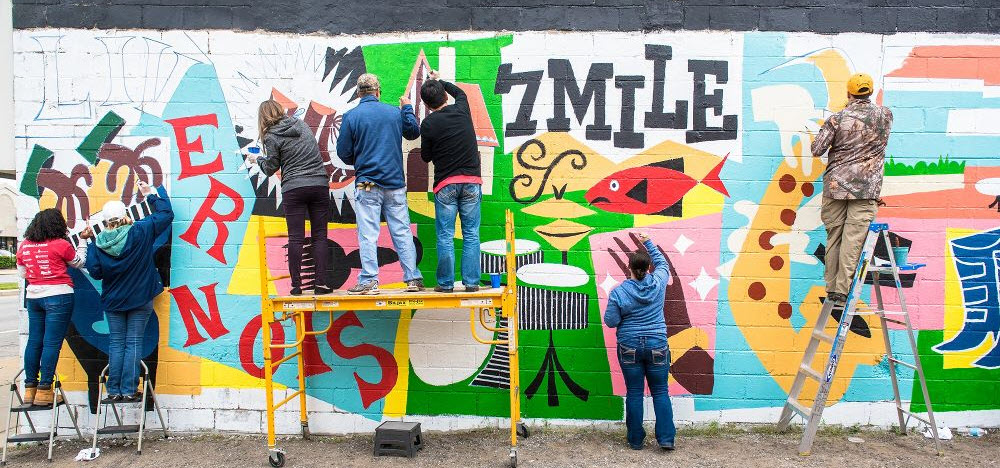Community Collaboration for Foundation Initiatives
Foundations seek to create positive community impact in their roles as communicators, connectors, conveners, catalysts, and funders. This vital work must be carried out in a complex and ever changing environment, and it requires cross-sector partnerships with organizations that have different resources, cultures, practices and missions.
The need for community partnership has been highlighted by the pandemic, and crystalized in the growing realization that creating health equity is everyone’s responsibility. It is now clear that the challenges facing our communities cannot be solved except through creative collaboration with the needs of community members at the center of the work.
At CHS we specialize in helping foundations solve the collaboration challenge by developing and supporting community collaboratives that bring community organizations together for learning and action. We have deep experience in helping diverse organizations work together to build capacity and create collaborative solutions to community challenges. The results can be seen in stronger relationships, creative synergy, and positive community impact.
Learn more about the possibilities below.
 Over the past 20 years CHS has supported numerous community collaboratives with a wide range of purposes and structures. Here we outline the basic elements of a community collaborative model.
Over the past 20 years CHS has supported numerous community collaboratives with a wide range of purposes and structures. Here we outline the basic elements of a community collaborative model.
Purpose. The purpose of a community collaborative is to help the member organizations elevate their community impact beyond what any of them might accomplish by working on their own. The particular purpose is typically chosen by the foundation with input from community stakeholders.
Formation. A collaborative forms when multiple organizations commit to working together for a shared purpose. Foundations can act as catalysts by convening and funding community collaboratives.
Participants. A collaborative can be structured to engage any number of participating organizations, from a few to dozens. Collaboratives work best when each member organization assigns a team of individuals to participate and accomplish the work.
Objectives. The specific objectives are defined in consultation with the collaborative members. Objectives typically involve a mix of aims for organizational capacity building (e.g., program design, team development, performance measurement) and community impact (e.g., reaching specific populations, assuring access to services, improving health indicators).
Timeframe. A collaborative can run from a few months to a few years depending on the purpose, objectives, and commitments of the members. A collaborative can also be structured to operate in phases, with strategic check-ins after each phase.
Activities. Collaborative members typically participate in group learning sessions, webinars, surveys, coaching calls, and an online learning hub. Members are expected to use what they are learning to produce demonstrable improvements. This work is supported with data, tools, technical assistance, and strategy coaching provided throughout the collaborative.
Workflow. In a typical collaborative the members progress through a workflow that involves considering community needs, designing specific improvement strategies, developing organizational capacity, implementing promising practices, sharing innovations, and evaluating impact.
Results. The results of a community collaborative include stronger organizational capacity, better performance, more robust collaboration, and greater community impact. The following section provides more details about the return on investment in a community collaborative.

Creating a community collaborative requires an investment of staff time and funding by the foundation. Research and experience show that a community collaborative can and should produce real benefits in return for this investment. Expected benefits include:
New relationships. The collaborative members build new relationships as a foundation for working together to address community challenges.
Creative synergy. The collaborative members generate creative approaches that are better than any might achieve by working on their own.
Stronger capacity. Each collaborative member develop stronger organizational capacity for achieving their community mission.
Better performance. Each collaborative member demonstrate positive results on key indicators of performance.
Sustainable innovation. The collaborative members produce practical innovations that create positive community impact and are sustainable for the future.
Greater community impact. The collaborative members demonstrate improvements in key elements of community reach, access, utilization, quality, and outcomes.
Clear accountability. In addition to the benefits outlined above, a community collaborative fosters clear accountability for results by routinely bringing members together to share their insights, ideas, challenges, innovations, and performance indicators.
These expected benefits can be weighed against the foundation’s investment of grant dollars and consulting costs to determine the return on investment in a community collaborative. In our experience foundations that use the community collaborative approach have been very satisfied with the benefits realized relative to costs.

CHS has supported community collaboration in a variety of settings and for a wide range of organizations. The examples outlined below illustrate just some of the possibilities.
|
Convener / Sponsor |
Challenge |
Solution |
Results |
|
Williamsburg Health Foundation |
Help safety net service providers build capacity to strengthen chronic care for community members who are uninsured or underinsured. |
The Chronic Care Collaborative. A community collaborative with eight organizations sharing group learning sessions, innovative strategies, tools, technical assistance, and coaching support. |
Stronger capacity for chronic care improvement; innovations in quality management, care delivery, access to care, SDOH assessment, patient self-management support, and clinical-community connections; high performance on benchmarked quality measures. |
|
St. David’s Foundation |
Help members of the Texas Association of Charitable Clinics build capacity to meet community needs and demonstrate quality. |
The Quality Collaborative. A community collaborative with six charitable clinics sharing group learning sessions, innovative strategies, tools, technical assistance, and coaching support. |
Stronger capacity for quality management; innovations in care delivery, access to care, SDOH assessment, patient self-management supports, and performance measurement. |
|
Richmond Memorial Health Foundation |
Help community clinics gain a better understanding of obstacles to utilization of dental care by uninsured patients, and develop strategies for improving access. |
Community Partners in Oral Health. A community collaborative with six organizations engaging in community-based action research and sharing group learning sessions, innovative strategies, tools, technical assistance, and coaching support. |
Stronger capacity for community-based action research; a rich knowledge base of community insight on patient needs and decision factors; innovations for improving access to care for safety net patients. |
|
Virginia Health Care Foundation |
Help community clinics build capacity to implement integrated care models for patients with depression and diabetes. |
Defeating the Deadly Double. A statewide collaborative with a community focus on six safety net healthcare providers sharing group learning sessions, innovative strategies, tools, technical assistance, and coaching support. |
Stronger capacity for integrated care; innovations in care team collaboration, care delivery, access to care, SDOH assessment, patient self-management support, clinical-community connections, and performance measurement. |
|
Potomac Health Foundation |
Help community service providers build capacity for improving access to community behavioral health services. |
The Potomac Mental Health Collaborative. A community collaborative of 15 community organizations sharing group learning sessions, innovative strategies, tools, technical assistance, and coaching support. |
Stronger capacity for program design and evaluation; innovations for improving access, assuring quality, and collaborating for service referrals across a wide range of community behavioral health services. |
|
Path Foundation |
Help community providers of senior services focus and align their efforts to optimize senior services and supports. |
A Senior Services Strategy Group. More than a dozen community stakeholders collaborating to share data, insights, and ideas for optimizing senior services. |
Consensus adoption of a strategic framework for creating community impact, a set of action design principles, and a set of strategic goals and action initiatives. |

Community collaboratives are typically focused on building capacity to address particular community issues. Some example topics and focus areas from our previous collaboratives are outlined below.
| Examples of Capacity Building Topics | Examples of Community Health Topics | (continued) |
|---|---|---|
|
|
|

At CHS we partner with foundations to co-produce community collaboratives that are tailored to accomplish the goals of the foundation and the particular objectives of collaborative members. Our deep and varied experience allows us to stand up a collaborative very quickly at a highly efficient cost.
Beyond helping with the structural aspects of creating a collaborative, we work closely with foundation staff on the relational aspects of development. At the initial stage of formation, we can provide guidance on how best to recruit members, encourage participation, and communicate about the objectives and expectations of the collaborative.
Throughout the collaborative we pay close attention to building and sustaining trust relationships, and this allows us to help participants navigate differences and develop consensus approaches. We also provide updates and seek strategic guidance from foundation staff at each step in the process.
With this relational context in mind, we use a proven, 15-step model to co-produce a community collaborative from beginning to end, as outlined below. Our first priority will be to listen and learn about your needs and interests, and then design a tailored approach that best meets your vision. .

- Define the purpose
- Engage members
- Consider community needs
- Define individual and shared objectives
- Identify promising practices
- Identify subject matter experts
- Develop learning resources
- Create an online learning hub
- Plan and facilitate learning sessions
- Enable peer knowledge sharing
- Provide coaching, tools, and technical assistance
- Document and spread innovations
- Assure accountability for results
- Evaluate impact
- Sustain and scale what works



